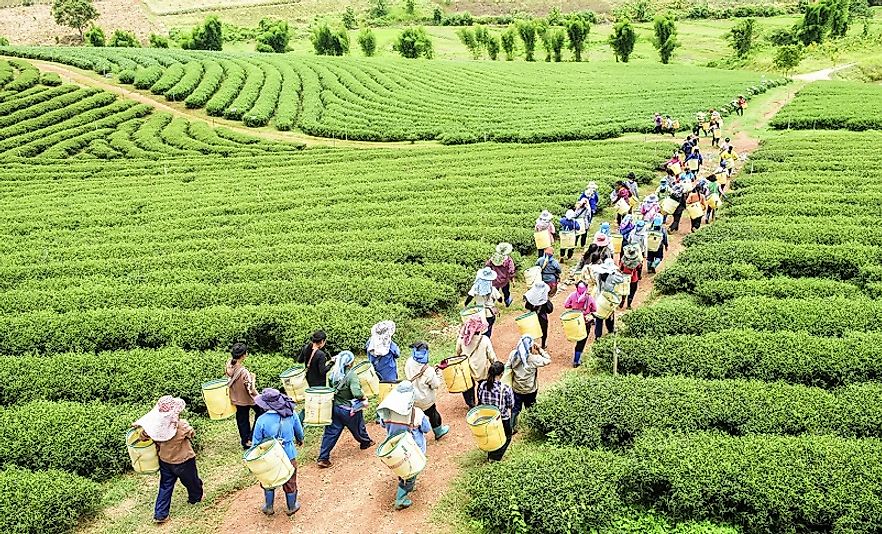Countries With The Most Organic Farmers

By 2014, there were more than 2.3 million organic farmers in the world, 13% more than the previous year. Since at least 2013 India has the most organic farmers, followed by Uganda and Mexico. Three-fourths of the world's organic producers are in Asia, Africa and Latin America, with 40%, 26%, and 14%, respectively. These figures are based on data from the private sector, certifying agencies, and governments. Included in these numbers are also the number of people involved in collecting wild produce, bee-keepers, and aquaculture farmers.
Numbers of Organic Farmers and Extents of Organic Farming By Country
India has 650,000 organic farmers. It has 0.7 million hectares under organic cultivation, and ranks second in Asia, next to China that has 1.9 million hectares under organic cultivation. Organic cultivation accounts for 0.4% of total agriculture. 210,000 hectares of land were added to organic farming in 2014 alone. Besides growers, India has nearly 700 organic processors and exporters.
Uganda is the African country with the largest number of organic farmers (191,000), as well as the leader in the region in terms of the extent of land under organic cultivation, with more than 240,000 hectares of the same. Its organic farms make up 1.7% of its total agricultural area. It is one of the largest producer of coffee in Africa.
170,000 of Mexico's farmers are organic cultivators, collectively using 2.3% of farming area in Mexico for organic operations. Besides growers, Mexico has nearly 100 organic processors. There are 166,000 organic farmers, and a few processors, and exporters in Philippines. The land under farming makes up 0.9% of farming area. In Tanzania the 149,000 organic farmers use 0.5% of farmland. There are also some companies involved in export. The 136,000 organic farmers and a few exporters in Ethiopia use 0.5% of farmland.
Land-use Patterns in Organic Farming
In Asia, 47% of the land is used for arable organic crops, including cereals, oil-seeds, textiles, green fodders, and medicinal plants. 15% of land is under organic permanent tree crops including coconut, tea, coffee, and tropical and sub-tropical fruits and nuts. Only 1% is permanent organic pastures, and 2% under other types of cultivation.
47% of the organic farms in African countries are under permanent tree crop cover, such as olives, tea, coffee, cacao, nuts, and tropical and subtropical fruits. 19% of land is for arable land crops including oil-seeds, textiles, medicinal plants, cereals and pulses. 5.6% of organic land is pastoral land. In Latin America, 67% of organic farms is permanent pastures, 12% is under permanent crop cover by coffee, cacao, and fruits (especially citrus and coconut), and 5% is used for such arable crops as cereals, sugarcane, vegetables, oil-seeds, and medicinal plants.
Domestic and International Trade of Organic Agricultural Products
Nearly all of the certified organic produce from Africa is earmarked for export, with Europe being the major importer. If organic cultivation is to become sustainable, domestic demand needs to rise in Africa. Uganda exports coffee, olives, nuts, cocoa, oil-seeds, and cotton.
Such Latin American countries as Mexico export organic produce to Europe, North America, and Japan, sending them products that cannot be grown in those countries. These exports center around tropical fruits, coffee, cocoa, sugar, meat, and grains.
In India, exports in organic produce have risen by 25-30% in recent, and the domestic organic consumption is up by 40%. The domestic Indian market is largely unorganized and currently amounts to $0.36 billion dollars, and is expected to increase by another billion dollars by 2020. Grains and pulses are most in demand in the domestic markets. Other Indian organic produce are sugarcane, oil-seeds, spices, tea, coffee, dried fruits, medicinal plants, and cotton, and are exported to the European Union, the United States, Canada, Australia, South East Asian countries, the Middle East, and South Africa.
Countries With The Most Organic Farmers
| Rank | Country | Number of Organic Farm Operations |
|---|---|---|
| 1 | India | 650,000 |
| 2 | Uganda | 191,000 |
| 3 | Mexico | 170,000 |
| 4 | Philippines | 166,000 |
| 5 | Tanzania | 149,000 |
| 6 | Ethiopia | 136,000 |











